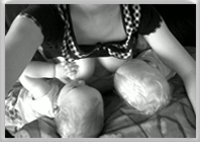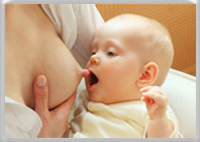Which Breastfeeding Positions are Your Favorite?
Breastfeeding positions play an essential role in you breastfeeding experience. There are some general principles that apply to any position. You can read about them here.
This section is about various breastfeeding positions. Modify them as needed to perfectly fit your situation.
Cradle Position

Position your baby across your chest just below the breast level.
You may
need to tuck a pillow underneath your baby to raise him/her. Or use a nursing pillow. Raising your
baby’s head a little higher than the rest of the body is ideal, especially for
reflux-prone babies. A nursing pillow can help you achieve this as well.
If you are sitting in a chair, armchair, rocking chair, sofa or the edge of the bed you can raise your feet up on a footstool. This will raise the level of your lap, if needed.
Turn your baby’s entire body to face you. Make sure your baby doesn’t need to twist, stretch or turn his/her head and neck to reach for the breast.
Support your baby’s back with your forearm.
Tuck something under the supporting arm (if not using a nursing pillow), so that you could relax.
When nursing on the left breast, support your baby with the left forearm. When on the right – support with the right forearm.
You baby’s head should be resting on your forearm, wrist or crook of your elbow, depending on your baby’s height.
Your free hand can at first support your breast to assist your baby with the latch-on. Once latched on you can use this hand to support the back of your baby’s head and neck.
Use the hand of the supporting arm to hold your baby’s bottom or thigh, depending on your baby’s height.
You baby’s lower arm can be placed around your waist or underneath your breast.
Your baby’s chin should be touching your breast. Turn your baby a little to achieve this. Your nipple should be leveled with your baby’s upper lip. This will ensure correct angle between your baby and the breast and leave space for your baby’s nose.
Don’t worry about your baby’s nose touching your breast. If you achieve correct positioning angle, he/she will have enough room for breathing.
Out of all breastfeeding positions this one works the best if you are walking around while nursing. You may add some rocking to it to relieve tension in your supporting arm.
This is one of the breastfeeding positions that works well for premature babies whose head, neck and back need more support during the feeding.
Cross-Cradle/Across-the-Chest Position

Position your baby across your chest just below your breast level.
You may need to tuck a pillow underneath your baby to raise him/her. Or use a nursing pillow. Raising your baby’s head a little higher than the rest of the body is ideal, especially for reflux-prone babies.
If you are sitting in a chair, armchair, rocking chair, sofa or the edge of the bed you can raise your feet up on a footstool. This will raise the level of your lap if necessary.
Turn your baby’s entire body to face you. Make sure your baby doesn’t need to twist, stretch or turn his/her head and neck to reach for the breast.
Support your baby’s back with your forearm.
Tuck something under the supporting arm (if not using a nursing pillow), so that you could relax.
When nursing on the left breast, support your baby with the right forearm. When on the right – support with the left forearm. This is the main difference between cradle and cross-cradle positions.
Your free hand can support your breast to assist your baby with the latch-on.
Your baby’s bottom and legs are resting on your thigh.
Use the hand of the supporting arm to hold your baby’s neck.
You baby’s lower arm can be placed around your waist or underneath your breast.
Your baby’s chin should be touching your breast. Turn your baby a little to achieve this.
Your nipple should be leveled with your baby’s upper lip. This will ensure correct angle between your baby and the breast and leave space for your baby’s nose.
Don’t worry about your baby’s nose touching your breast. If you achieve correct positioning angle, he/she will have enough room for breathing.
Out of all breastfeeding positions this one gives you the best view of your baby’s latch-on. It works best with smaller babies.
Football/Clutch/Side/Under-the-Arm Position

Position your baby next to you parallel to your body.
Your baby’s head should be leveled with your breast (see picture).
Your baby’s face should be just in front of your breast (see picture).
Your baby’s feet should be directed towards your back.
If there is not enough room behind you for your baby’s feet, you can help your baby raise his/her legs up and place the feet against the support you are leaning on.
Support your baby’s back and shoulders with the arm on the same side where the baby is. It will look like you are holding a “football”.
Support your baby’s neck and base of the head with the hand and fingers of the supporting arm. Refrain from directly pushing on your baby’s head.
Tuck something under the supporting arm (if not using a nursing pillow), so that you could relax.
Your free hand can support your breast to assist your baby with the latch-on.
If your baby ends up lower than your breast you may push his/her upper body
up a little into a half-seated position. A nursing pillow works well for that.
Your baby’s chin should be touching your breast.
This position leaves more space between your baby’s nose and your breast. You won’t have to worry about your baby not breathing easily.
This is one of the breastfeeding positions that works well after a C-section delivery. Your baby’s body is not on your abdomen, which alleviates pressure on the incision area.
It also works best if you have larger breasts or flat or inverted nipples.
This hold gives you a better view of your baby’s latch-on.
Out of all breastfeeding positions this one works well for premature babies whose head, neck and back need more support during the feeding.
Lying-Down/Side-Lying Position

Lie on your side.
Place your baby next to you parallel to your body and facing you.
You can place a pillow behind your baby’s back to support it.
You can use some pillows to support your body too.
You can place your lower arm around your baby to raise his/her head (especially helpful with reflux-prone babies).
You can also use your lower arm to rest your head on and let your baby’s head rest on the bed.
Vary position of your lower arm depending on the size and shape of your breasts and your baby’s preferences.
Use your free hand to support your breast to assist your baby with the latch-on.
Keep your body in straight line. You may need to place a pillow under your head and between your legs.

Your baby’s head should be at the level of your breast.
Your nipple should be leveled with your baby’s upper lip.
Make sure your baby’s body is in a straight line. Shift his/her position slightly to re-adjust.
Make sure your baby doesn’t need to twist, stretch or turn his/her head and neck to reach for the breast.
In this picture the baby is positioned incorrectly. Baby's neck is twisted and baby's body doesn't face mom's body.
Important: American Academy of Pediatrics does not recommend co-sleeping with your baby. If you take your baby into your bed for nursing, return him/her to the crib after that.
Out of all breastfeeding positions this one is good for regulating your milk flow. In case of oversupply lying down slows down the flow.
In case of elongated breasts try breastfeeding from the opposite breast: left breast when you are lying on your right side, and right breast when on your left side.
This position is good for breastfeeding after C-section delivery or any complicated delivery that is restraining your movements.
Laid-Back Position*/Biological Nurturing*
This type of breastfeeding is all about giving your baby the freedom to lead and manage the feeding process. You two are following your biological instincts and reflexes.
You recline against your bed pillows and place your baby on your tummy. And then let him/her lead and follow the rooting reflex (a reflex prompting a baby to open his/her mouth when his/her lips or cheeks are touched).
If needed you can move your baby closer to the breast or shift the position slightly. But let your baby find the nipple himself/herself and start breastfeeding.
Besides laid-back position you may also try sitting-up position*, but let your baby lead.
I find biological nursing a very natural and holistic way of breastfeeding. There are no set instructions, rigid rules and guidelines. Many mom-baby couples prove to be very successful in it.
It maximizes skin-to-skin contact, touching, caressing and your baby's involvement in the process.
It lets your baby find the most comfortable position for enjoying the meal and freely using his/her hands to discover the breast.
Here is more about the role of touch and baby's hands in breastfeeding (this link will open a new window and take you to our friends at Nurture Through Touch).
You can try biological nurturing and if it works – great – go with it. If your baby doesn't seem to know what to do on the breast, or if there are problems calling for intervention, follow more traditional breastfeeding positions described above.
As you master your breastfeeding skills get creative about your breastfeeding positions. Some moms are extremely successful with kneeling down above their lying baby and breastfeeding this way. This position works well with twins too.
*This method is described by La Leche League and Doctor Suzanne Colson.
Home › Positioning Basics › Breastfeeding Positions













